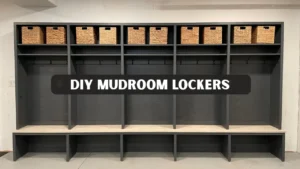A library book cart is a versatile piece of furniture that helps keep books organized and easy to move. Whether for a classroom, home, or public library, building your own cart can be a cost-effective and rewarding DIY project. Customizing the size, design, and style allows it to fit perfectly in your space. This guide will provide step-by-step instructions for creating a durable and functional cart.
By following these instructions, you can craft a cart that combines practicality with aesthetics. Smooth edges, sturdy shelves, and optional features like wheels enhance usability. A personalized design ensures the cart meets your specific storage needs. Start this project to enjoy an organized, stylish, and mobile solution for your books.
Key Takeaways:
- Learn how to design and build a durable library book cart for home, classroom, or library use.
- Discover the materials, tools, and detailed step-by-step instructions for a successful project.
- Gain practical tips for customization, safety, and long-lasting use.
Why Build a Library Book Cart
There are several advantages to building your own library book cart rather than purchasing one.
- Customization: You can adjust the number of shelves, dimensions, and design features to fit your space and style perfectly. This flexibility allows you to create a cart that meets both functional and aesthetic needs.
- Cost-effective: Building a library cart yourself often costs less than purchasing high-quality pre-made options. DIY projects also let you save money while using materials of your choice.
- Durability: Choosing strong materials and careful construction ensures the cart lasts for many years, even under heavy use. Proper assembly and reinforcements prevent sagging and improve long-term stability.
- Creative satisfaction: Crafting your own furniture allows you to apply woodworking skills and enjoy a rewarding DIY project. You can also personalize finishes and decorative touches to match your room.
- Mobility and versatility: Adding caster wheels and handles makes the cart portable and easy to move in classrooms, home libraries, or shared spaces. Lockable wheels and smooth rotation make it safe and convenient to transport books.
Even small tweaks, such as adding dividers or finishing touches, can make the cart more functional and visually appealing. Building your own book cart gives you full control over aesthetics and functionality.
Materials and Tools You Will Need
Materials:
- Hardwood planks (oak, maple, or pine) for shelves and sides
- 1×2 or 2×2 wood strips for supports
- Wood screws and nails
- Wood glue
- Sandpaper (80–220 grit)
- Finish or paint for aesthetics
- Four swivel caster wheels (preferably lockable)
Tools:
- Table saw or circular saw
- Power drill with appropriate drill bits
- Screwdriver or impact driver
- Measuring tape
- Carpenter square
- Clamps
- Pencil for marking
- Safety gear including gloves and goggles
Measuring twice before cutting is essential to prevent mistakes and ensure all parts fit together properly.
Step by Step Instructions
1: Design and Measurements
- Determine overall size: Decide the height, width, and depth of your book cart based on the space available and the size of the books you plan to store. Proper sizing ensures the cart fits comfortably in your intended location.
- Typical dimensions: A functional cart is usually around 36 inches tall, 24 inches wide, and 12 inches deep per shelf. These measurements provide enough space for standard books while keeping the cart compact.
- Sketch your design: Draw the cart on paper or use basic woodworking software to visualize the final product. Visualizing the design helps identify potential adjustments before cutting any wood.
- Plan shelf spacing: Consider spacing shelves to accommodate larger books, binders, or special collections. Adjustable spacing allows flexibility as your book collection grows or changes.
2: Cutting the Wood
- Cut panels and shelves: Follow your design measurements to cut all panels and shelves accurately. Accurate cuts ensure all parts fit together seamlessly during assembly.
- Smooth edges: Use sandpaper or a planer to ensure all edges are smooth. Smooth edges also make handling the pieces safer and easier.
- Pay attention to corners: Take extra care with corners and edges, especially if children will use the cart. Rounded and smooth corners reduce the risk of injuries.
- Improve safety and appearance: Smooth edges prevent scratches and give the cart a polished, professional look. Proper finishing also enhances the overall durability of the wood.
3: Assemble the Frame
- Attach the shelves evenly within the frame according to your design. Properly spaced shelves make it easier to organize and access books.
- Drill pilot holes before inserting screws to prevent wood from splitting. This also helps ensure screws go in straight and hold securely.
- Secure each shelf with screws and wood glue for maximum stability. Using both fasteners provides long-lasting strength for heavy books.
- Use a level to ensure all shelves are even and properly aligned. Even shelves prevent books from sliding and keep the cart visually balanced.
4: Attach Shelves
- Evenly position the shelves within the frame. Proper spacing ensures balanced weight distribution and easy access to books.
- Drill pilot holes to prevent the wood from splitting. This also makes inserting screws easier and strengthens the connection.
- Secure each shelf using screws and wood glue for stability. Using both methods ensures the shelves remain sturdy over time.
- Use a level to ensure all shelves are uniform and properly aligned. Correct alignment prevents books from sliding or tipping over.
5: Install Wheels
- Attach four swivel caster wheels to the bottom corners of the cart. This provides stability while allowing easy movement in any direction.
- Use lockable wheels for classrooms or busy areas to prevent unwanted movement. Locking the wheels keeps the cart securely in place when not in use.
- Ensure the wheels rotate smoothly for easy mobility. Properly installed wheels reduce strain when pushing or pulling the cart.
- Smooth-rotating wheels make it easier to move the cart even when it is fully loaded with books. This helps prevent tipping or accidents while transporting heavy loads.
6: Sanding and Finishing
- Sand the entire cart, focusing on corners, edges, and all surfaces. This ensures a smooth, professional finish and prevents splinters.
- Apply a finish, varnish, or paint according to your preference. Choosing the right type of finish can enhance the cart’s durability and appearance.
- Allow the finish to dry completely before placing books on the cart. Rushing this step can cause smudges or damage to the coating.
- A durable finish protects the wood from scratches, moisture, and long-term wear. It also makes cleaning and maintenance easier over time.
Case Study
- A local elementary school built a DIY library book cart using oak and lockable wheels. After three years of daily use, it still supports over 60 books per cart without any sagging or damage.
- A home library enthusiast customized a three-shelf rolling cart with dividers and painted finish. It perfectly fits the room’s aesthetic while providing easy mobility for weekly book rotations.
Tips for Durability and Customization
- Use hardwood for heavy books to prevent sagging.
- Add a handle or rope on one side for easier mobility.
- Consider adding labels or dividers to organize books by genre or age.
- Optional: Install a bottom tray for extra storage.
- Smooth edges and rounded corners increase safety, especially for children.
- Lockable wheels improve stability in classrooms or busy environments.
- You can add decorative trims, carved designs, or personalized paint to match your library aesthetic.
- Reinforce shelves with additional support strips if planning to store textbooks or oversized books.
Common Mistakes to Avoid
- Always measure carefully and double-check your cuts before starting assembly. Mistakes in measurements can cause parts to not fit properly and affect the cart’s stability.
- Avoid using softwood for shelves that will hold heavy books, as it may sag over time. Choosing hardwood ensures long-term durability.
- Always wear safety gear such as gloves and goggles when cutting or drilling. Ignoring safety precautions can lead to serious accidents.
- Do not overload shelves beyond the recommended weight limits for your chosen wood type. Overloading can warp shelves and reduce the lifespan of the cart.
- Take your time during assembly to ensure all parts are level and secure. Rushing can result in uneven shelves or a wobbly, unstable cart.
Optional Design Variations
- Modern Cart: Minimalist design with metal accents and light-colored wood. This style works well in contemporary spaces and blends seamlessly with modern furniture.
- Rustic Cart: Distressed wood with natural finish, ideal for cozy home libraries. Its textured look adds warmth and character to any reading corner.
- Kids’ Library Cart: Lower height, bright colors, and extra safety features like rounded corners. It encourages children to explore books independently while keeping them safe.
- Expandable Cart: Adjustable shelves or modular sections for growing book collections. This flexible design allows you to add or remove shelves as your library evolves.
Conclusion
Building your own DIY library book cart is a rewarding project that combines practicality and creativity. By choosing quality materials and following detailed instructions, you can create a functional piece that fits perfectly in your home or library. Adding features like dividers or lockable wheels increases usability and convenience. This project also gives the satisfaction of making a customized furniture piece tailored to your needs.
With careful finishing and smooth edges, the cart will be safe and durable for years. Adjustable shelves and design customization allow it to match any room’s aesthetic. Whether for organizing books or moving them easily, this project delivers both style and practicality. Start building today to enjoy a functional and visually appealing storage solution.
FAQs
What materials are best for a library cart?
Hardwoods like oak or maple are ideal for strength, while pine is lightweight and easier to cut.
How many books can a DIY book cart hold?
A typical three-shelf cart can hold between 50–70 average-sized books, depending on shelf size and wood type.
Can I make the cart mobile?
Yes, adding swivel caster wheels makes it easy to move. Lockable wheels are recommended for safety.
Is it safe for children?
With smooth edges, proper finishing, and lockable wheels, the cart is safe for children to use.
Can I customize the design for a home library?
Absolutely. You can adjust dimensions, colors, and add decorative elements to match your space.




